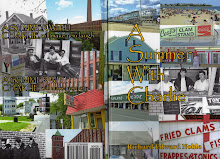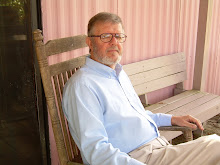Phoenix Harbor PUD
[Journalism 101: This is another article that appeared in the Franklin Chronicle by yours truly. I think it is significant to the world at large because of the environmental debate taking place in our “little sleepy fishing village” boarding on the beautiful Apalachicola Bay here in Franklin County, Florida.]
By Richard E. Noble
Dan Garlick
“My name is Dan Garlick. I am the agent for the developer; I am not the developer. This is a planned use change ... I have been working on this for about eight months now. The project consists of 28 acres more or less on St. George Island located in the Northwest corner of the causeway of Franklin Boulevard and North Bay Shore Drive. What we propose to do on that 28 acres is to create 58 units … We plan to place these units on lands that are currently zoned commercial and residential and out of that land we are going to “gift” 2.5 acres that are going to be given to the County for a boat ramp and whatever uses the County would like … a restroom and a parking area. Why are we doing this? Basically what we have right now is a tract of land that has several items on it that are sensitive to say the least. You have wet lands; you have an eagle’s nest that is active; and you have very important shellfish waters that are adjacent to the site. The land right now has density around it that is higher than we propose [some are 3 units per acre; some are 8 units per acre; some are 12.9 units per acre; and some are commercial and 1 unit per acre – the commercial zones at present zoning could be restaurants, hotels, motels or a marina]. The reason that we have chosen to go this route is that we realize that this is a sensitive area.” Mr. Garlick then went on to outline his developer’s plans to protect the environmental sensitivities mentioned above – the eagle’s nest, the runoff problems and type roads, the sensitive shellfish areas etc. “We are not doing this just because we want to do it; we have to do it to a certain degree. If we didn’t want to do it, we would just go back to the commercial aspects and go that route. We think that we can meet what the State requires for Advanced Waste Water Treatment – which is the sewage part …” Mr. Garlick then stated environmental safety procedures that the developer has incorporated into his plan. “The issues that have come up in regards to the units is still – is what I am going to say is - the fear and mistrust of what this project could do to shellfish waters. I can assure you that if you go with the principal uses your impacts are going to be substantially higher than what we are proposing ... How are you going to contend with people who make their living on the Bay (if something negative happens)?” Mr. Garlick then informed the Board that his developer would be willing to impose a 20 thousand dollar fee on each and every new home to be constructed within the development. This money would be given to the County and placed at its discretion.
At this point the public was asked to offer comments. There were more than twenty individuals who spoke in favor of the project and a half a dozen or so he spoke against the project. The arguments were traditional with regards to this matter. If you have lived here for any length of time you know most of them by heart yourself. I will deal with a few from each side who are representative of the opposing ideas.
Dave McLain – Riverkeeper
“The recommendations as the Taskforce reached them in consensus – The Task Force consensus was that the County Commission consider a density of one dwelling per acre due to the sensitivity of the Apalachicola resources at risk in this CHHA (Coastal High Hazard Area); further that if instead the Commission favorably considers approval the Planned Unit Development of 58 units proposed by the developer, that a one time up-front mitigation fee be assessed of twenty thousand dollars per dwelling unit and paid by the developer as a part of the public benefit to be accrued by a PUD prior to the issuance of any land clearing permit to be dedicated to activities to be approved by your Task Force to support sustainable commercial seafood in Franklin County. And that the two (2.5) acre plot offered to the County should be a constructed and dredged boat ramp with adjacent toilet facilities which will be a part of that public benefit bound with a perpetual covenant to be available to commercial seafood launch and recovery as a matter of priority.
Dan Garlick then stated that he and his developer could deal with and accept all of the above – dredging, boat ramp with facilities, twenty thousand per unit up front or a (previously mentioned) performance bond of one million dollars.
Jeannie McMillian – Islander and Business Owner
“I’m Jeannie McMillian and I live on the Island. One of my concerns is the traffic. You have 58 units assuming two cars per unit; you’ve got a Budweiser truck, a Miller Light truck and a Gas truck; blocking almost every morning to get out on Island drive.” She went on to describe boats and trailers and no access for cars on the main roads. “My other concern is that I really don’t know what advanced waste water is. I just know what I saw after Dennis. I saw sewage being pumped by the County into the Gulf; I saw aerobic systems popped up; I saw sewage everywhere. And the closer a sewage treatment plant is to the Bay – whether it is advanced or not; which is about three foot lower than the beach - is going to be a catastrophe. If the electricity is off it will not be doing what it is supposed to do. Fifty-eight units means about 180 toilets … we really need to look at that … you are only two blocks away from the bay.”
Ruth Schoelles
“I’m the realtor on this project … and let me tell you first that what I would lose on this project would not outweigh what I would gain. The Schoelles have been in the oyster business for a long, long time. My husband operated an oyster house here for years. This is a good project. I worked with this property for three or four years. I had several developers talk to me about it. I met Mr. Strickland. He is the first person in forty years that I have worked with that first wanted to talk to me about environmental. He talked to County people to see what the best use of that piece of land could be and he could still make a profit from. My first question is in lieu of what has currently been built there why does anybody think that this little piece of land is going to shut down that bay?” Ms. Schoelles then turned to the audience and requested a response. The audience began to rumble and then one man said that every little bit hurt; another person said that 58 units was too many; another grumbled about sewerage and the grumbling rippled about the room. “Now if this shuts down this bay two of my boys will lose their livelihood. We (now) have a marina that just oystermen put in – no sports boats or anything. They have been putting in at that little marina for years. I have a one hundred and fifty acre (oyster) lease that will shut down. If I didn’t think that this was a good project do you all think that I would risk losing that? We have other people in this County who need jobs – I have five boys. One boy had to leave because he could find no job here. After everything else has been developed over there, why all of a sudden does everybody think that this is going to close the bay?”
Helen Sphorer
“I’m Helen Sphorer and for the record, I am not the developer of this project. I am one of the current owners of the property. My partners and I completely support the plan that Mr. Strickling has put forward with Dan Garlick. We believe that the plan that he has put forward has many, many benefits for Franklin County. To me one of the great benefits of this is that the developer is giving the County waterfront property. I think that having a public boat ramp with (facilities) and a parking area is an incredible amenity for the tourist, for the residents and for the commercial fishermen. I think that another benefit of this land is that it is changing the use of the land from commercial to a lower density residential. I think this will give an economic boost to Franklin County right now … I think this will also increase the tax base … I am in the real estate industry and our industry has been very slow for the last eighteen months and there are many people who have had to leave this industry and take other jobs. I have had to lay people off and close offices. Approving a project like this would send such a strong message that there are still investors willing to invest in this area. But I believe that the biggest benefit to Franklin County and all the people is the fact that we would have an advanced waste water treatment plant – not on the bay but back off the bay. Advanced waste water treatment is the best protection. I know that any development decision is very difficult for any of you to make. I don’t envy any of your positions sitting up there tonight but I would like to ask for your consideration and ask that you vote to approve this project.”
Willard Vinson – Ex-County Commissioner
“Hey, I’m so excited! This sounds like Christmas and the Fourth of July all at the same time, don’t it? But it reminds me of the story about the apple and the garden. You know what Satan told Eve; Go ahead, you surely won’t die … right now.
“I might not be around fifteen or twenty years from now to say I told you so; but some of these young people will be. This is the only place in the world where you can buy and Apalachicola oyster. People come down here because the environment is decent, the water is clean – they can go swimming, fishing and they are not afraid. Prevailing winds go from east to west so any pollution that you have at this end of the bay will wind up in that other end of the bay - the west end of the bay. You have got to understand that. Some of you have been around thirty or forty years and you still don’t understand that. It’s not just what happens now; it is what happens later. You don’t have a current in that area that can keep that flushed out. It will get stagnated in there. You can only put on a sponge so much and pretty soon it won’t absorb any more. And that is what we are faced with on that Island. And this is a serious situation. I know everybody is in favor of this – it sounds good to me. Sounds like pie in the sky to me. But I can’t understand you commissioners being willing to gamble – if you are – the future of our bay because a few years ago the building was great and we had oystermen started building. But now building’s got bad; and guess where they are today? They are making good money out on Apalachicola bay because the water is clean. I want to remind you that what you do tonight and what you do with this project will have an effect on what you do on the north side of the bay in a few months. Because they (also) are going to give you a great thing and then you are between Porter’s Bar and Cat Point. Over on the Island you are between East Hole and Hotel Bar. Why in the world do you want to forfeit something that produces and is beneficial to the whole state – to the whole United States as well as Franklin County for something that might be – if so-and-so don’t happen? What is their guarantee going to be fifteen or thirty years from now? I’m going to ask you to turn this project down. What you got to do is look down deep inside and say; I don’t care what everybody says, I’m going to have the courage to do what’s right. I’m asking you to turn this down – and I love every one of you - be good to your neighbors and you will have better neighbors dog-gone you!”
Doctor David Hiel – Florida Dept of Agricultural and Consumer Services
“Thank-you for letting me speak. I do provide information – not a direct recommendation to your planning and zoning Board; to the Oyster and Seafood Task Force and I will be glad to provide information to you.
“Come on; bring it to us.” said Ms. Sanders.
“You bet yah. We don’t get directly involved in planning and zoning issues,” explained Dr. Heil but it makes sense for us to be advisors to you. We don’t want to make decisions. You have a tough decision to make here. We care about Apalachicola Bay water quality for the sustainability and oyster harvesting. You have the most productive bay in the northern hemisphere and you would not want to do things that jeopardize that resource. There are certain things that directly impact shellfish harvesting waters. Sewage treatment is extremely important. If there was to be a surface water discharge proposed by this project – which there is not – we would be closing a lot of shellfish waters. Marinas and docking facilities? – any time we have more than ten boats – we have to close a lot of shellfish waters. What I can tell you is that this project – as proposed – will not automatically close shellfish harvesting waters. Based on everything about this project … it would be okay in my opinion to approve this project. No guarantee that storm water won’t impact the bay; no guarantee that pet waste won’t impact the bay; no guarantee that the sponge is full and these (new) units will cause the bay to close – some day we will be faced with that (full sponge). I can’t tell you when that is going to be. Through all the issues that I’ve heard, I have made the recommendation to the Task Force to approve this project – even though I don’t really recommend approval or denial. But they did ask for my opinion as an advisor to the Task Force and I was glad to give it.”
“You are the one’s that open and close it (the bay)?” asked Mr. Lockley.
“I’m the one that opens and closes it. If for example sh-t shows; we close. And that is our job.”
Ms. Sanders then asked Dr. Heil for an estimation of the cost of reclaiming the area if it were to be devastated. He estimated the oyster beds at approximately 80 thousand dollars per acre and he had no estimate for the cost of any possible damage to the grass beds.
The discussion went on and on and then finally it was time for the Board to make a decision. There was a long, very noticeable silence. Mr. Crofton asked for a motion several times but no motion came forward. Islanders in the audience began to call for Commissioner Crofton to pass the gavel – the unspoken understanding being that Mr. Crofton being from the Island, a resident of the plantation, certainly he would make a motion in favor of this PUD. Mr. Crofton refused to pass the gavel on the grounds that he didn’t think that passing the gavel would be fair to his fellow commissioners.
As the silence grew and grew the audience began to rumble and grumble among themselves. Finally Mr. Putnal spoke up. “I’ll tell you what, I’ll make a motion. I make the motion that because this is a high hazard zone; because it is right on the water and because it has potential to hurt that bay; and I’m an oysterman and I make my livelihood out there. I make a motion that we deny it.” Then Mr. Putnal sputtered into his shirt collar – “and the motion will die because of lack of a second.”
“Are you denying this PUD that we have before us?” asked Mr. Parrish.
“I’m denying the PUD – the whole thing – the proposal we have before us.”
“I second it,” Mr. Parrish said without hesitation.
“Okay we have a second. Is there any discussion?”
“Yeah, I'm going to go along with that motion,” said Mr. Lockley. “When I took my office I told everybody that I wouldn’t do anything to hurt this bay and I just ain’t comfortable with this.”
The decision was then passed unanimously. Initially there was shock then a slow and sporadic applause sputtered over and equal volume of groans and moans to the contrary.
Monday, February 12, 2007
Subscribe to:
Post Comments (Atom)





































No comments:
Post a Comment